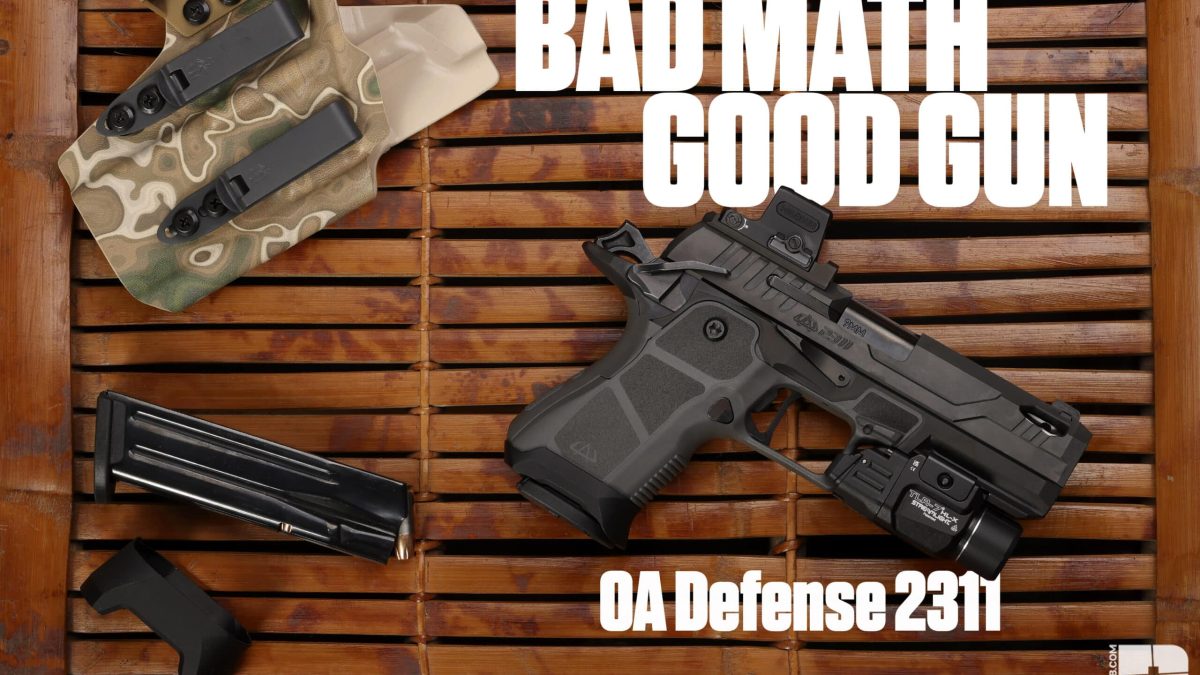The double-stack 1911-pattern pistol, colloquially known as a 2011, has long been a darling of competitive shooters. In more recent years, it’s become a hot segment for tactical and self-defense users as well. While “2011” is actually a Staccato trademark, we’ll use the term in this article like you’d use the word “Kleenex” in conversation rather than “facial tissue.”
Putting aside emotion, John Moses Browning vibes, and fads, what makes these guns so enduringly popular for serious users, especially since they’re fundamentally based on a design from the 1900s?
Arguably the most significant appeal of these guns comes from their amazing shootability. To be fair, that’s not a real word, but the fact is that many people feel that they shoot better with 2011s than other pistols. Folks often describe them as a cheat code, finding it easier to shoot well with a 2011. Not everyone feels this way, but enough people do that there’s clearly something to it.
This mostly boils down to ergonomics and mechanics. Many shooters find the 1911 grip angle to feel very natural, helping them present it properly on target more consistently. The beavertail and manual safety encourage a high and secure grip, especially if the user firmly rides the thumb safety while shooting. This provides a lot of leverage on the gun and keeps your grip as high as possible, while maintaining consistency since it has a distinct feel that you can lock into the same way every time.
The single-action trigger on a 2011 can be tuned to perfection. You’re releasing a fully cocked hammer, so it can be sublimely crisp and as light as you’re willing to go. It’s exactly the same every time. Notably, the trigger travels straight back; it doesn’t pivot like most other triggers.
All of this contributes to the ability to have an amazing trigger pull. Since your goal as a shooter is to avoid disturbing your sights while pressing the trigger to break a shot, a great straight-pull trigger is very helpful to achieve this, on top of the solid platform provided by the grip we just discussed.
All of these factors make follow-up shots and transitions seem easier too. As they say, while software trumps hardware, good gear can amplify your efforts.
It’s easy to see why so many shooters love this platform. Check out our Springfield Armory Prodigy review in CONCEALMENT Issue 41 for a deeper dive into the full history of 2011 pistols.
OA 2311 COMPACT PRO SPECS
- CALIBER: 9x19mm
- BARREL LENGTH: 4.25″
- DIMENSIONS: 7.75″ L | 5.10″ H | 1.40″ W
- WEIGHT (UNLOADED): 25oz
- TRIGGER WEIGHT: 3.5-4.0lbs
- CAPACITY: 15+1 Rounds
- FRAME: 7075 Aluminum
- GRIP: OA Gray Polymer
PROS:
- SIG P320 Magazines
- Crisp trigger
- Optics plate
CONS:
- $2,350 MSRP
- Optic plate screws came loose
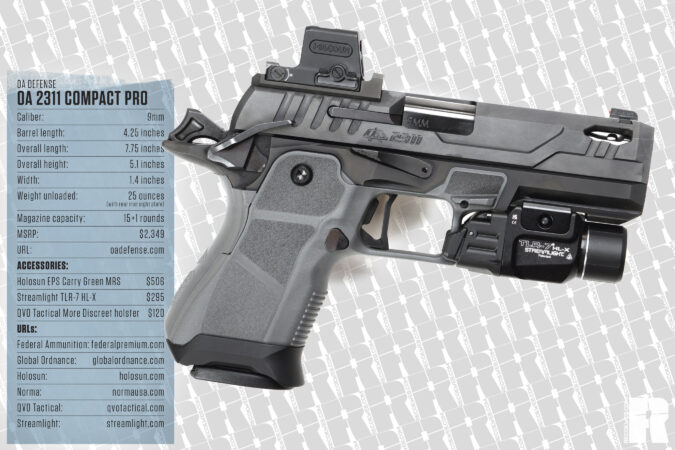
WHAT’S THE CATCH?
Building a good 2011 has always been labor-intensive, and labor has gone from cheap to expensive. At the same time, modern manufacturing has also improved by orders of magnitude. So while these guns still command quite a premium, the barrier to entry keeps getting lower while quality and consistency keep increasing.
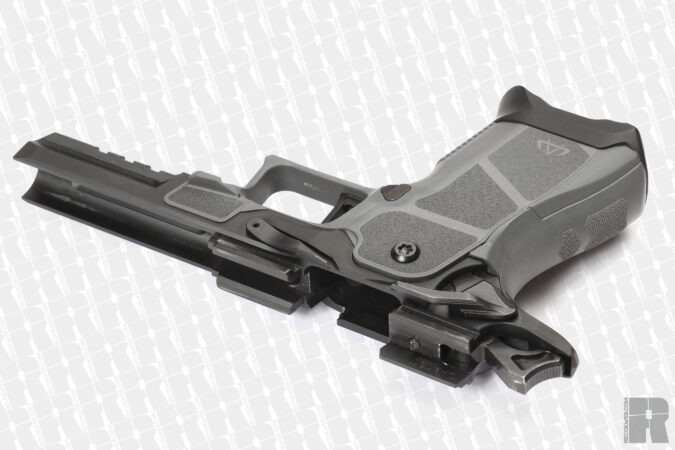
Magazines have always been the Achilles’ heel of this platform. We still remember when you had to painstakingly tune your magazines to run reliably in your gun (or pay someone to do it for you). However, once set up, these guns would run like sewing machines — the round counts on USPSA match guns can be staggering.
Additionally, 2011s weren’t designed for the smaller 9mm cartridge. Magazines and the grip are larger than they need to be, and feeding might not be as reliable as with native chamberings.
However, we’re in a golden age for 2011s now, with reliable (albeit expensive) factory magazines and many manufacturers building great guns. Staccato’s made an art of it and filled duty holsters all across the country with 2011s. That’s a mission critical application for law enforcement that folks decades ago wouldn’t have thought possible.
WHAT IF?
OA Defense created the OA 2311 by asking a big “What if?” What if you merged a race gun and duty weapon to make the best modern version of a 2011 possible? What if you combined the modular 2011 frame/grip, the fantastic 1911 trigger, the simpler bushingless and linkless barrel from a CZ75, and native 9mm SIG P320 magazines? That was their goal with the OA 2311 series, and what you see here is the latest incarnation, the OA 2311 Compact Pro.
The Compact Pro is sized for EDC, with a 4.25-inch barrel and a grip that accommodates 15-round P320 magazines. The “Pro” designation indicates that it’s been upgraded with a ported barrel, cut and contoured slide, enhanced trigger, and extended magazine release. The full-size OA 2311 will be the next to get the “Pro” treatment.
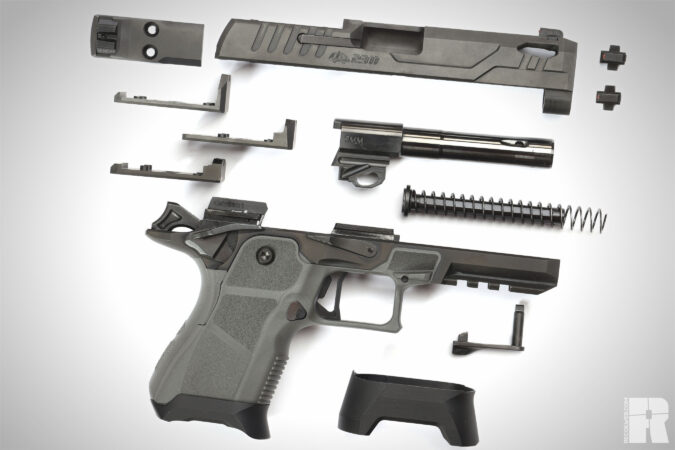
The barrel has integral V-porting, with matching cutouts in the slide. There are additional cuts to lighten the slide for faster cycling and make it look cool. Standard Night Fision tritium night sights come installed on the slide and cover plate. Optic plates for RMR, DPP, and RMSc/Holosun K footprints are provided. Backup rear iron sights are machined into the plates and positioned in front of the optic; OA thoughtfully also provides intermediate and tall front sights to match. Available separately are ACRO and SRO plates.
The barrel locks up on the ejection port and the extractor is external, like other modern pistols.
The frame and grip module are like a 2011, with a 7075 aluminum serialized frame and polymer grip. There’s a dust cover with a Picatinny accessory rail on one end and a smooth beavertail on the other.
The ambidextrous thumb safety clicks positively up and down, with a wider lever on the left side and a thin one on the right. Unheard of for a 2011, the slide release is ambidextrous as well, with a lever on the right side that’s slaved to the primary lever on the left.
The 2311’s trigger is based on the series 70 1911 system. The hammer, sear, and disconnector are fully compatible with series 70 parts. However, the mainspring, mainspring housing, sear spring, and trigger bow assembly have been modified and are proprietary. Any gunsmith who works on 1911s can tune your 2311. The Pro model comes with an enhanced trigger; ours broke cleanly at 3.5 pounds with a bit of take-up and a short and positive reset.
Note that there’s no grip safety, though OA says the 2311 has been drop-test certified by a third party for duty use.
To go with the P320 magazines, the 2311 incorporates a P320 mag release, so it can be installed on either side; on the Pro, it’s upgraded to a Springer Precision extended unit. Thumb ledges are built into the grip on both sides just forward of the trigger guard to provide additional leverage to control the gun.
They protrude out further and are more effective than those on most other factory guns. The grip itself has a relief for your middle finger and molded ribs on the front strap. Because P320 mags are designed for 9mm, they’re smaller than 2011 mags, and thus the 2311’s grip is smaller as well. The side panels and back strap have modest texturing.
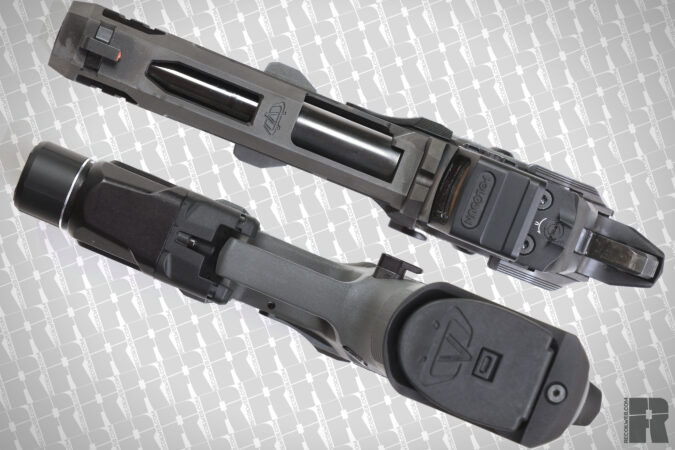
The Compact Pro comes with a metal magwell for quick reloads. You can swap it out for an extended grip and heavily flared magwell that corresponds with 17-round magazines. The standard package includes five 15-round mags and a nice, padded bag made by Savior. Or you can opt for the “Plus Kit” package that comes with the extended magwell installed and five 17-rounders. The magwells are also available separately so you can switch between them — for instance, carrying it daily with the short grip and installing the long one to shoot a match on the weekend. Color options include black, gray, and high desert with either black or sage accents.
GOING HOT
The supplied Night Fision sights are excellent, but an optic is a must-have on a gun like this. Installing the RMSc plate, we were pleased to see a recoil lug to save the two screws that secure it. Positioning the backup rear sight in front of the optic accomplishes a few things: it moves the optic further from the ejection port and the attendant crud, it helps protect the optic during slide manipulations (e.g. racking it on hard surface), and it places the reticle behind it.
A Holosun EPS Carry nestled happily in the optic plate and is a great match for the Compact Pro. One note about installation — make sure to use some thread locker on the screws, as advised in the manual. They’re not that long and will work loose.
Knowing we needed to remove everything for photos right after a quick range trip, we figured we could get away with torquing them tight and applying Loctite later. Within about 100 rounds, the optic plate screws had already backed out.
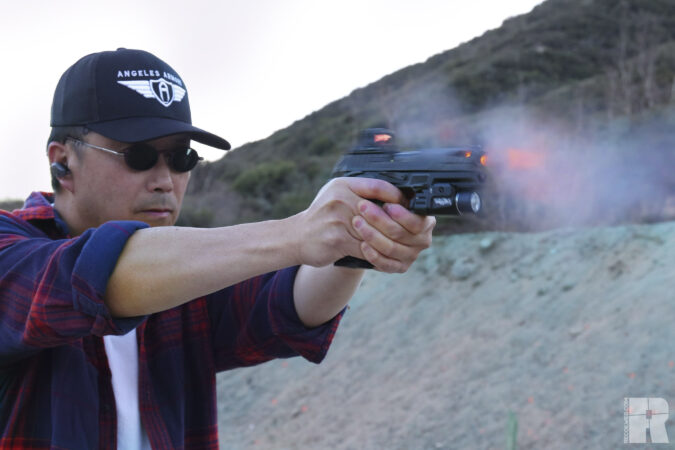
For a weapon light, the Streamlight TLR-7 HL-X matched up nicely with the dimensions of the trigger guard and dust cover. It also worked well in conjunction with the thumb ledge to get additional leverage on the gun for those with larger hands.
We found accuracy to be good but not outstanding like our old-school 2011s; think roughly 2-inch groups at 25 yards. We tried FMJ from CCI, Norma, and Igman, as well as Punch defensive loads and Gold Medal Action Pistol from Federal. The Gold Medal 147-grain ammo grouped a little better than the rest. We’d love to see OA squeeze a little more accuracy out of these guns. All ran reliably, with no issues. One specific magazine wouldn’t reliably lock back when empty; the follower was a bit off.
QVO Tactical is a reliable source of holsters for new or lesser-known guns; indeed, they had a fitment for the Compact Pro. The 2311 isn’t a tiny gun; QVO’s More Discreet IWB holster with a concealment wing pulled the grip tight against our body and was comfortable for all-day carry. We configured it with a high sweat guard, RELV Moab camo print, and double DCC belt clips. You can opt for a weapon light version as well.
As far as shootability goes, the OA 2311 delivers all of the advantages we talked about at the beginning of this article. Thanks to the native 9mm magazines, the smaller grip makes it even better for shooters with smaller hands. Between the grip, wide thumb safety, and front thumb ledge, you can really lock down the gun. Add in the ports, and recoil is extremely controllable. It points very naturally and returns right back on target for multi-shot strings.
All of our testers loved shooting this gun. One with larger hands much preferred the extended grip, while others were perfectly happy with the short grip; the flared magwell helped bridge the gap. One with stubby fingers wished the thumb ledges extended just a little further back. Some wanted an option for a flatter backstrap — they’re easily interchangeable but OA hasn’t released any alternatives yet.
The grip texturing looks to strike a balance between traction and comfort on your naked belly; we’d generally prefer to tip the scale toward a little more grip. OA says they were designed with custom stippling in mind for you to customize it to your preference. Overall, OA Defense did a great job on this mash-up, creating a pistol with a great combination of characteristics that can be used as a duty, home defense, or competition gun.
If you do the math, 2011 plus 320 equals 2331, not 2311. If you add 75 too, that’s 2406. But we’ll give them a pass on their arithmetic. If you can get your hands on an OA 2311 — even better, to shoot one — you’ll understand
Read the full article here

